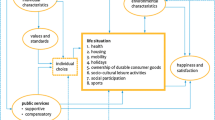Abstract
The concept of ‘quality of life’ as a tool of comparative social indicators research is analyzed. Inter-city comparisons of objective and subjective measures of well being are presented and the distinctiveness of these two dimensions of the quality of life is documented. The paper concludes with some observations on the implications that this distinctiveness has for the use of the concept ‘quality of life’ in future social indicators research.
Similar content being viewed by others
Bibliography
AndrewsF. and WitheyS.: 1973, ‘Developing Measures of Perceived Life Quality: Results from Several National Surveys’, Institute for Social Research, Ann Arbor, Michigan.
CampbellA.: 1972, ‘Aspiration, Satisfaction and Fulfillment’, in A.Campbell and P.Converse (eds.), The Human Meaning of Social Change, Russell Sage, New York, pp. 441–466.
Campbell, A., Converse, P., and Rodgers, L.: 1972, paper presented at the Conference on Subjective Measures of the Quality of Life, November 14, 15, 1972, Ann Arbor, Michigan.
CampbellA. and ConverseP. (eds.): 1972, The Human Meaning of Social Change, Russell Sage, New York.
CazesB.: 1972, ‘The Development of Social Indicators: A Survey’, in A.Shonfield and S.Shaw (eds.), Social Indicators and Social Policy, Heinemann Educational Books, London, pp. 9–22.
FlaxM.: 1972, A Study in Comparative Urban Indicators: Conditions in 18 Large Metropolitan Areas, Urban Institute, Washington, D.C.
GastilR.: 1970, ‘Social Indicators and Quality of Life’, Public Administration Review, 30, no. 6, pp. 596–601.
HenriotP.: 1972, Political Aspects of Social Indicators: Implications for Research, Russell Sage, New York.
RossiP.: 1972, ‘Community Social Indicators’, in A. Campbell and P. Converse, Political Aspects of Social Indicators: Implications for Research, Russell Sage, New York. pp. 87–126.
SchumanH. and GruenbergB.: 1970, ‘The Impact of City on Racial Attitudes’, American Journal of Sociology 76, 213–261.
SheldonE. and MooreW. (eds.): 1968, Indicators of Social Change, Russell Sage, New York.
SmithD.: 1973, The Geography of Social Well Being in the United States: An Introduction to Territorial and Social Indicators, McGraw-Hill Book Company, New York.
SpringerM.: 1970, ‘Social Indicators, Reports and Accounts’, The Annals 388, 1–13.
StagnerR.: 1970, ‘Perceptions, Aspirations, Frustrations and Satisfactions: An Approach to Urban Indicators’, The Annals 388, 59–68.
United States Department of Health, Education and Welfare: 1969, Toward a Social Report, Government Printing Office Washington, D.C.
Author information
Authors and Affiliations
Rights and permissions
About this article
Cite this article
Schneider, M. The quality of life in large American cities: Objective and subjective social indicators. Social Indicators Research 1, 495–509 (1975). https://doi.org/10.1007/BF00353066
Received:
Issue Date:
DOI: https://doi.org/10.1007/BF00353066




